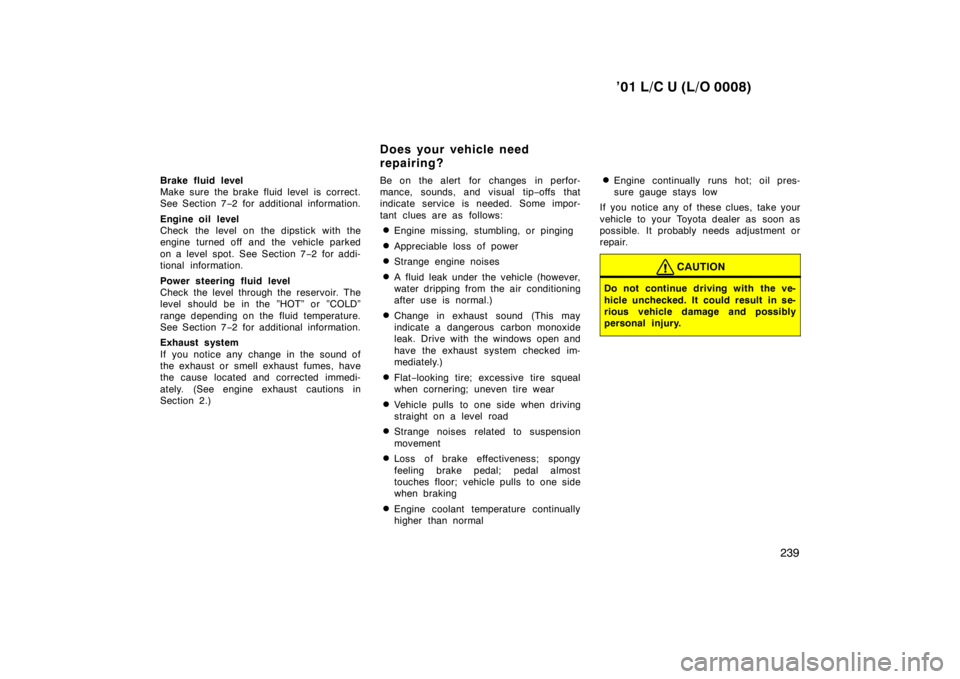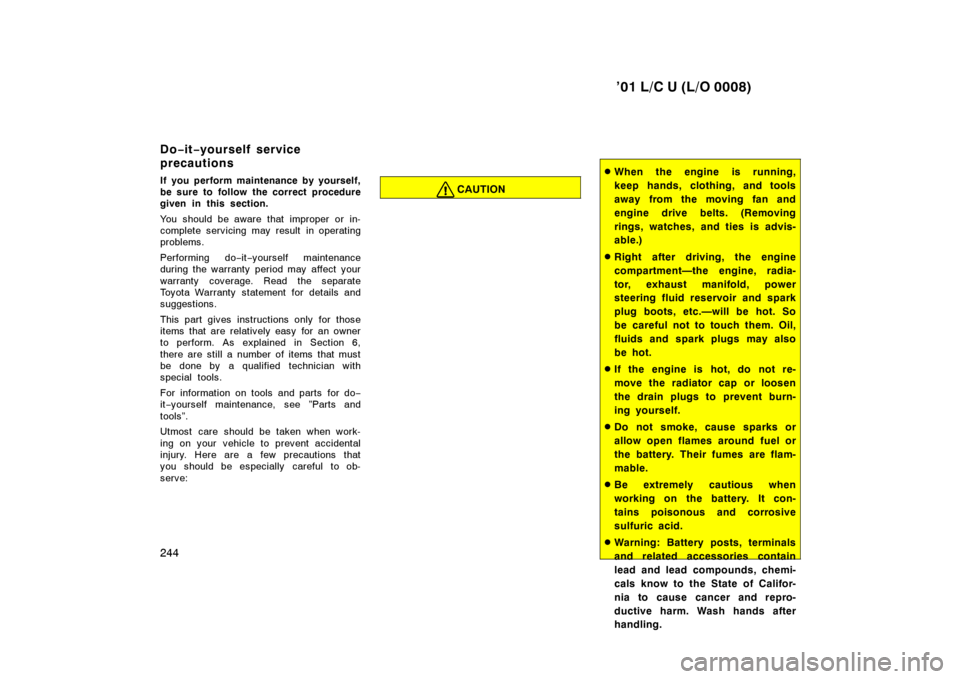Page 110 of 142

’01 L/C U (L/O 0008)239
Brake fluid level
Make sure the brake fluid level is correct.
See Section 7
−2 for additional information.
Engine oil level
Check the level on the dipstick with the
engine turned off and the vehicle parked
on a level spot. See Section 7 −2 for addi-
tional information.
Power steering fluid level
Check the level through the reservoir. The
level should be in the ”HOT” or ”COLD”
range depending on the fluid temperature.
See Section 7 −2 for additional information.
Exhaust system
If you notice any change in the sound of
the exhaust or smell exhaust fumes, have
the cause located and corrected immedi-
ately. (See engine exhaust cautions in
Section 2.) Be on the alert for changes in perfor-
mance, sounds, and visual tip
−offs that
indicate service is needed. Some impor-
tant clues are as follows:
� Engine missing, stumbling, or pinging
� Appreciable loss of power
� Strange engine noises
� A fluid leak under the vehicle (however,
water dripping from the air conditioning
after use is normal.)
� Change in exhaust sound (This may
indicate a dangerous carbon monoxide
leak. Drive with the windows open and
have the exhaust system checked im-
mediately.)
� Flat −looking tire; excessive tire squeal
when cornering; uneven tire wear
� Vehicle pulls to one side when driving
straight on a level road
� Strange noises related to suspension
movement
� Loss of brake effectiveness; spongy
feeling brake pedal; pedal almost
touches floor; vehicle pulls to one side
when braking
� Engine coolant temperature continually
higher than normal �
Engine continually runs hot; oil pres-
sure gauge stays low
If you notice any of these clues, take your
vehicle to your Toyota dealer as soon as
possible. It probably needs adjustment or
repair.
CAUTION
Do not continue driving with the ve-
hicle unchecked. It could result in se-
rious vehicle damage and possibly
personal injury.
Does your vehicle need
repairing?
Page 113 of 142
’01 L/C U (L/O 0008)
242
Engine compartment overview
1. Engine oil filler cap
2. Brake fluid reservoir
3. Fuse blocks
4. Battery
5. Windshield and rear window washerfluid tank
6. Engine oil level dipstick
7. Engine coolant reservoir
8. Electric cooling fan
9. Power steering fluid reservoir
Page 115 of 142

’01 L/C U (L/O 0008)
244
If you perform maintenance by yourself,
be sure to follow the correct procedure
given in this section.
You should be aware that improper or in-
complete servicing may result in operating
problems.
Performing do
−it−yourself maintenance
during the warranty period may affect your
warranty coverage. Read the separate
Toyota Warranty statement for details and
suggestions.
This part gives instructions only for those
items that are relatively easy for an owner
to perform. As explained in Section 6,
there are still a number of items that must
be done by a qualified technician with
special tools.
For information on tools and parts for do −
it −yourself maintenance, see ”Parts and
tools”.
Utmost care should be taken when work-
ing on your vehicle to prevent accidental
injury. Here are a few precautions that
you should be especially careful to ob-
serve:
CAUTION
� When the engine is running,
keep hands, clothing, and tools
away from the moving fan and
engine drive belts. (Removing
rings, watches, and ties is advis-
able.)
� Right after driving, the engine
compartment—the engine, radia-
tor, exhaust manifold, power
steering fluid reservoir and spark
plug boots, etc.—will be hot. So
be careful not to touch them. Oil,
fluids and spark plugs may also
be hot.
� If the engine is hot, do not re-
move the radiator cap or loosen
the drain plugs to prevent burn-
ing yourself.
� Do not smoke, cause sparks or
allow open flames around fuel or
the battery. Their fumes are flam-
mable.
� Be extremely cautious when
working on the battery. It con-
tains poisonous and corrosive
sulfuric acid.
� Warning: Battery posts, terminals
and related accessories contain
lead and lead compounds, chemi-
cals know to the State of Califor-
nia to cause cancer and repro-
ductive harm. Wash hands after
handling.
Do −it −yourself service
precautions
Page 117 of 142

’01 L/C U (L/O 0008)
246 �
Use only spark plugs of the speci-
fied type. Using other types will
cause engine damage, loss of per-
formance or radio noise.
� Do not reuse iridium −tipped spark
plugs by cleaning or regapping.
� Do not overfill automatic transmis-
sion fluid, transfer oil and power
steering fluid, or the transmission,
transfer and power steering could
be damaged.
� Do not drive with the air cleaner
filter removed, or excessive engine
wear could result. Also backfiring
could cause a fire in the engine
compartment.
� Be careful not to scratch the glass
surface with the wiper frame.
� When closing the engine hood,
check to see that you have not for-
gotten any tools, rags, etc.
Parts and tools
Here is a list of parts and tools you will
need on performing do −it−yourself mainte-
nance. Remember all Toyota parts are de-
signed in metric sizes, so your tools must
be metric.
Checking the engine oil level
Parts (if level is low):
� Engine oil API grade SJ,
”Energy −Conserving” multigrade or
ILSAC multigrade having viscosity
proper for your climate
Tools: � Rag or paper towel
� Funnel (only for adding oil)
Checking the engine coolant level
Parts (if level is low): � ”TOYOTA Long Life Coolant” or equiva-
lent
See Section 7 −2 for details about cool-
ant type selection.
� Demineralized or distilled water
Tools:
� Funnel (only for adding coolant) Checking brake fluid
Parts (if level is low):
� SAE J1703 or FMVSS No.116 DOT 3
brake fluid
Tools:
� Rag or paper towel
� Funnel (only for adding fluid)
Checking power steering fluid
Parts (if level is low):
Automatic transmission fluid DEXRON �
II
or III
Tools:
� Rag or paper towel
� Funnel (only for adding fluid)
Checking battery condition
Tools: � Warm water
� Baking soda
� Grease
� Conventional wrench (for terminal
clamp bolts)
Page 134 of 142

’01 L/C U (L/O 0008)
276
Oil type:
Standard differential
Hypoid gear oil API GL −5
Limited −slip differential
Hypoid gear oil for limited −slip differ-
ential API GL −5
Recommended oil viscosity: Above −18 �C (0 �F)
SAE 90
Below −18 �C (0 �F)
SAE 80W or 80W −90
CHASSIS LUBRICATION
Wheel bearings: Lithium base wheel bearing grease,
NLGI No.2
Front drive shaft thrust bushings: Synthetic oil and lithium soap base
chassis grease, NLGI No.1
Propeller shafts: Lithium base wheel bearing grease,
NLGI No.2 BRAKES
Minimum pedal clearance when depressed
with the force of 490 N (50 kgf, 110 lbf)
with the engine running, mm (in.):
116 (4.6)
Pedal free play, mm (in.): 1—6 (0.04—0.24)
Pad wear limit, mm (in.):
1.0 (0.04)
Lining wear limit, mm (in.): 1.0 (0.04)
Parking brake adjustment when pulled with
the force of 196 N (20 kgf, 44 lbf): 4—6 clicks
Fluid type: SAE J1703 or FMVSS No.116 DOT 3
STEERING
Wheel free play: Less than 40 mm (1.6 in.)
Power steering fluid type: Automatic transmission fluid DEXRON �
II
or III Tires
Tire size:
P275/70R16 114S
Tire pressure, kPa (kgf/cm 2
or bar, psi):
Normal driving Front 200 (2.0, 29)
Rear 220 (2.2, 32)
Trailer towing Front 200 (2.0, 29)
Rear 240 (2.4, 35)
Wheel size: 16 � 8JJ
Wheel nut torque, N·m (kgf·m, ft·lbf): 131 (13.4, 96.6)
NOTE: For a complete information on tires (e.g. replacing tires or replacing
wheels), see ”Checking tire pres-
sure” through ”Aluminum wheel
precautions” in Section 7 −2.